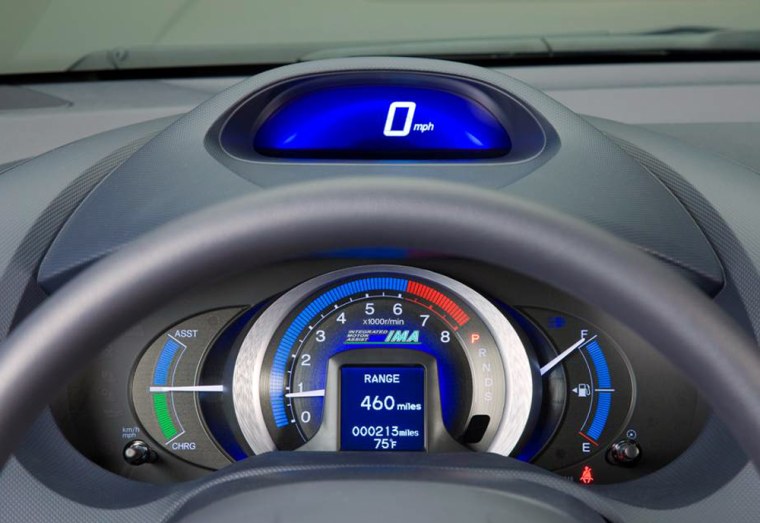Watch out, Toyota Prius. Honda's new gasoline-electric hybrid car has aerodynamic styling like yours but carries a lower price, offers video game-like "scoring" for fuel-thrifty driving and is arguably a more fun ride.
In fact, several people — not car buffs, by any means — instantly mistook the 2010 Honda Insight test car for Toyota's best-selling hybrid vehicle. When told the five-seat, five-door hatchback was a new Honda instead, they shrugged and readily accepted the Insight as a Prius alternative.
Environmentally minded shoppers aren't likely to be the only ones who will buy the Insight.
With a manufacturer's suggested retail price, including destination charge, of $20,470 for a base model with 88-horsepower 1.3-liter, four-cylinder engine mated to a 10-kilowatt electric motor for a total of 98 horses, the Insight arrives in showrooms priced $2,250 less than the base 2009 Prius.
The current Prius, with 110 horsepower from its four-cylinder engine and electric system combined, has been the top-selling gas-electric hybrid vehicle in the United States and around the world since its debut in Japan in 1997 and in this country in 2000. U.S. sales of the Prius hit 180,000 in 2007.
All other hybrids are priced higher than the Prius and the new Insight. The 2009 Honda Civic Hybrid starts at $24,320, the 2010 Ford Fusion Hybrid sedan at $27,995, and the 2009 Nissan Altima Hybrid sedan at $27,345.
The Insight price is no accident. Company officials said they want the new car to give more buyers a chance to try a hybrid without having to pay a high premium for the technology. In recent years, hybrids have typically run $2,000 to $3,000 higher in purchase price than comparable cars.
Don't confuse the 2010 Insight with the Insight that Honda sold from 1999 to 2006.
The original was a cramped two-seater whose exterior styling was reminiscent of a big insect, and everything, including seat foam, was metered to reduce weight and thus, boost fuel mileage, even at the expense of comfort. It boasted the best fuel mileage of any new car in America — 52 miles per gallon in combined city/highway travel. But its buyer pool was limited.
The 2010 Insight retains a couple of the styling cues — the sloping rear hatchback glass and the glass at the end of the tailgate, for example.
Lower mileage, higher fun
But fuel mileage is estimated at 40 mpg in the city and 43 mpg on the highway. This is less than the 48/45-mpg of the 2009 Prius, but because the new Insight offers some nifty digital fuel-mileage aids on the dashboard, it may draw interest from younger buyers who love video games.
For example, it includes several ways to monitor fuel economy as you drive beyond the usual on-board mpg readout. Like the Prius, there's a diagram showing exactly how power is being generated and apportioned from the engine, electric motor and battery storage.
But the Insight goes farther with an Ecological Drive Assist System (Eco Assist) that allows a driver to earn leaves on small digital plants in a dashboard display.
The driver must push the "Econ" button on the dashboard first in order to have the car adjust throttle control, operation of the continuously variable transmission and air conditioner as well as the idle-stop feature for best fuel economy. Then, each time the car is turned off, the plants appear to show how well or poorly a driver did in maximizing fuel economy during that trip.
In another nod to video gamers, the seemingly three-dimensional background of the Insight's speedometer goes from green (efficient use of gas) to blue (not efficient) to reflect fuel usage. Only problem was I liked the cool look of the blue background best.
For all the attention given to digital readouts and fuel use monitoring, the Insight rides like a regular car without the numerous electronic gimmicks found in modern cars.
There's no key-free ignition button, for example. Instead, a driver inserts a key into the ignition and turns it to start the car. There's also no sunroof or onboard music hard drive available. But the Insight comes standard with regular features such as automatic climate control, power windows and tilt and telescoping steering wheel as well as a full complement of safety items.
It's also roomy inside, despite being a few inches shy of the mid-size Prius. With rear seats folded down, the Insight's 15.9-cubic-foot trunk is bigger than the 14.4 cubic-foot trunk in the Prius.
Road bumps but nice handling
I felt many road bumps in the tester, which was tiring over long drives. I heard road noise much of the time, too, but the aero styling seemed to keep wind noise to a minimum.
Handling and steering in the front-wheel drive, compact Insight were comfortable and pleasing, and since Honda balanced the Integrated Motor Assist programming of the 1.3-liter, four-cylinder engine and electric motor for good get up and go in both city and highway travel, the Insight conveys less of an artificial sensation of driving than does the Prius.
At least two car enthusiast magazines have noted the Insight's fun-to-drive character compared with the Prius.
There are places where cost-savings show, however. Cargo floor material feels cheap and ceiling material isn't the rich, textured stuff found in Volkswagens. The horn is a cheap-sounding, little-car "beep-beep" thing, and in the morning sun, a noticeable glare bounced from the top of the scooped-out dashboard on the front-passenger side onto the windshield.
